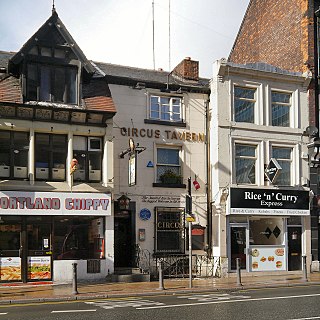
Castleton is a village and civil parish in the High Peak district of Derbyshire, England, at the western end of the Hope Valley on the Peakshole Water, a tributary of the River Noe, between the Dark Peak to the north and the White Peak to the south. The population was 642 at the 2011 Census.

Burslem is one of the six towns that along with Hanley, Tunstall, Fenton, Longton and Stoke-upon-Trent form part of the city of Stoke-on-Trent in Staffordshire, England. It is often referred to as the "mother town" of Stoke on Trent. The population of the town was included under the Burslem Central ward and had a population of 6,490 in the 2021 Census.

The Portico Library, The Portico or Portico Library and Gallery on Mosley Street in Manchester, England, is an independent subscription library designed in the Greek Revival style by Thomas Harrison of Chester and built between 1802 and 1806. It is recorded in the National Heritage List for England as a Grade II* listed building, having been designated on 25 February 1952, and has been described as "the most refined little building in Manchester".

Piccadilly Gardens is a green space in Manchester city centre, England, on the edge of the Northern Quarter.

Prestbury is a village and civil parish in Cheshire, England, about 2 miles (3 km) north of Macclesfield. At the 2001 census, it had a population of 3,324; it increased slightly to 3,471 at the 2011 census. The ecclesiastical parish is almost the same as the former Prestbury local government ward which consisted of the civil parishes of Prestbury, Adlington and Mottram St Andrew.

Little Hayfield is a hamlet in the Peak District National Park, in Derbyshire, England. It lies on the A624 between Hayfield and Glossop. At the centre of the hamlet is the Lantern Pike pub, named after the nearby hill of the same name. Fell racing take place in Little Hayfield, and until 2021 an annual country show was held on a local farm, including sheepdog trials.

Rowarth is a hamlet about 2.5 miles (4 km) north of New Mills in the High Peak borough of Derbyshire, England. It is on the edge of the Peak District, in the hills between New Mills and Marple Bridge, within the parish boundary of New Mills.

The Old Red Lion (ORL), also known as the Old Red Lion Theatre (ORLT) and The Old Red, is a pub and fringe theatre, at Angel, in the London Borough of Islington.

Chunal is a hamlet in Derbyshire, England. It is located on the A624 road, 1 mile south of Glossop. The philosopher Ludwig Wittgenstein conducted aeronautical research at Chunal during his time as an engineering research student at Manchester University (1908–1911). He flew kites into the upper atmosphere.

Peveril Castle is a ruined 11th-century castle overlooking the village of Castleton in the English county of Derbyshire. It was the main settlement of the feudal barony of William Peverel, known as the Honour of Peverel, and was founded some time between the Norman Conquest of 1066 and its first recorded mention in the Domesday Survey of 1086, by Peverel, who held lands in Nottinghamshire and Derbyshire as a tenant-in-chief of the king. The town became the economic centre of the barony. The castle has views across the Hope Valley and Cave Dale.
There are many Grade II listed buildings in the city of Manchester, Greater Manchester, England. The majority of Manchester's listed buildings date from the Victorian (1837–1901) and Edwardian (1901–1911) eras, most as a consequence of the Industrial Revolution. In England and Wales, the authority for listing is granted by the Planning Act 1990 and is administered by English Heritage, an agency of the Department for Culture, Media and Sport. There are three categories of listing – Grade I, Grade II* and Grade II.

The Flying Horse is a Grade II* listed public house at 6 Oxford Street, Marylebone in the City of Westminster. It was built in the 19th century, and is the last remaining pub on Oxford Street. The pub is on the Campaign for Real Ale's National Inventory of Historic Pub Interiors.

The Dolphin is a Grade II listed public house and nightclub at 165 Mare Street, Hackney Central in the London Borough of Hackney, London.
The Railway is a Grade II listed pub in Altrincham, Greater Manchester, England.

The Shakespeare is a Grade II listed public house at 1 Glynne Street, Farnworth, Greater Manchester BL4 7DN.

The Thurland Hall is a Grade II listed public house in Nottingham.

The Champion is a 19th-century public house in Wells Street in the Fitzrovia area of the City of Westminster, London. It is notable for the presence of stained glass windows and a snob screen, a Victorian feature preserved to the present day in only a few pubs.

The Circus Tavern on Portland Street in Manchester, England, is the smallest public house in the city, with one of the smallest bars in the country.
Manchester is a city in Northwest England. The M1 postcode area of the city includes part of the city centre, in particular the Northern Quarter, the area known as Chinatown, and part of the district of Chorlton-on-Medlock. The postcode area contains 194 listed buildings that are recorded in the National Heritage List for England. Of these, 14 are listed at Grade II*, the middle of the three grades, and the others are at Grade II, the lowest grade.
The Castle Hotel is a historic public house in the Northern Quarter area of Manchester, England. The Campaign for Real Ale considers it to have an "interior of exceptional national historic importance."

















